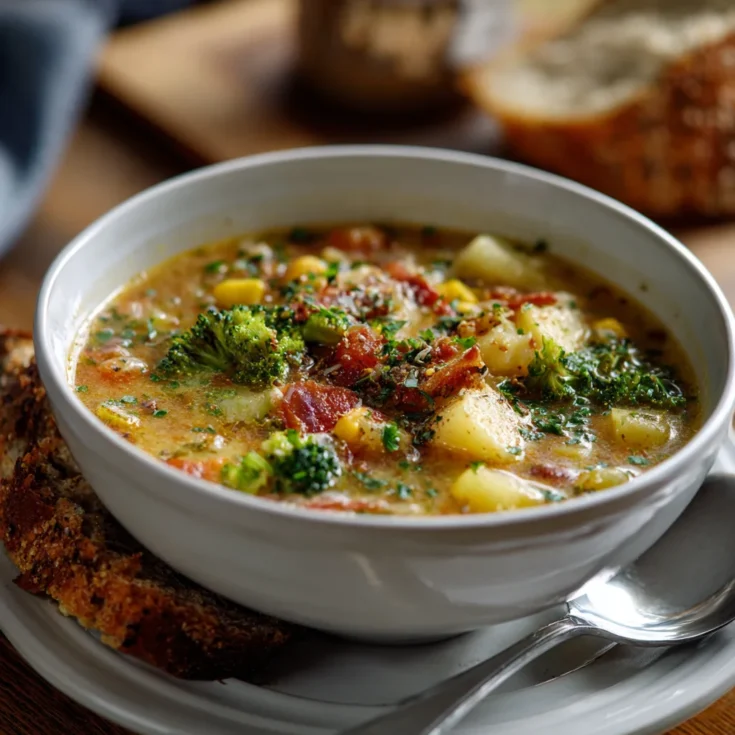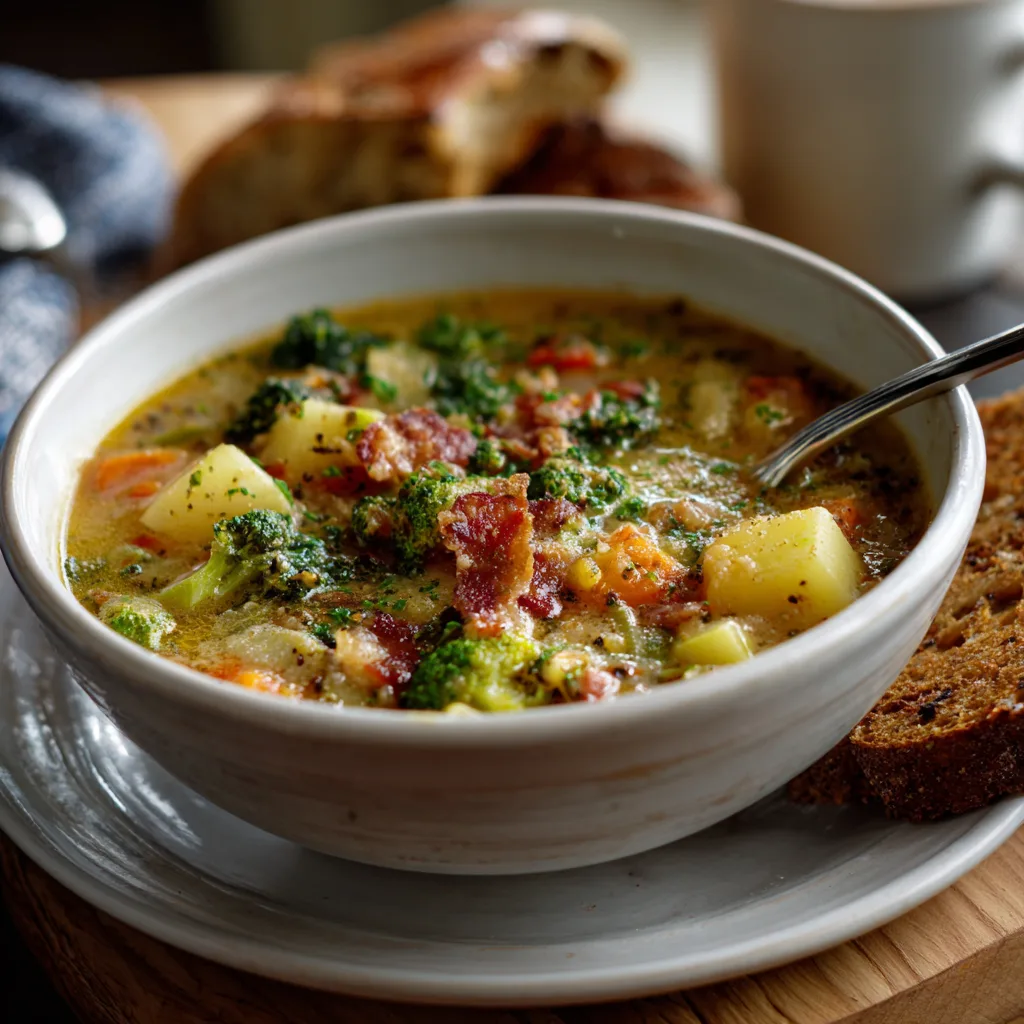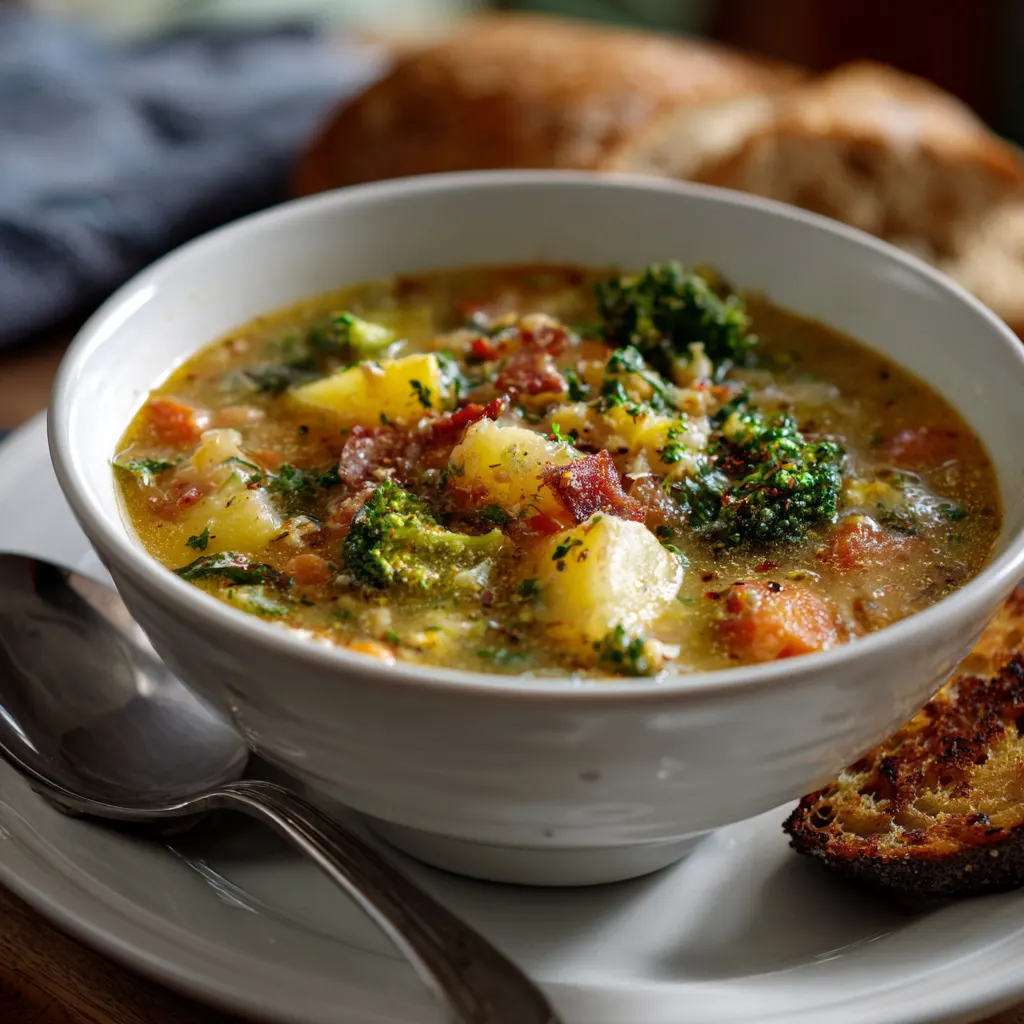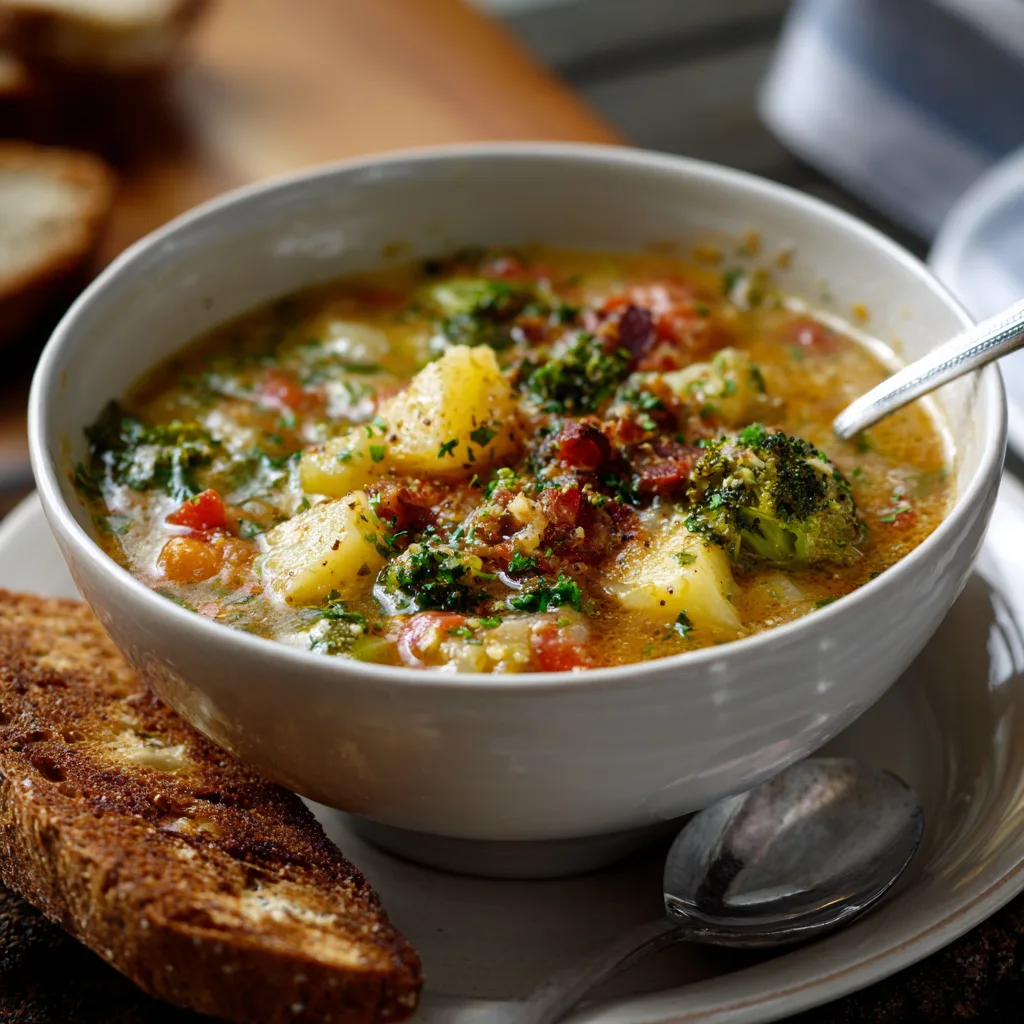Hearty Vegetable Chowder
Few dishes bring the same comfort as a steaming bowl of hearty vegetable chowder. This soul-warming classic is more than just a soup—it’s a wholesome meal in a bowl. Packed with colorful vegetables and layered flavors, it offers nourishment and satisfaction in every spoonful. Whether enjoyed on a chilly evening or as a quick, wholesome lunch, it has earned a spot in kitchens around the world. Its versatility makes it a favorite among home cooks and food lovers alike.
At its core, hearty vegetable chowder stands out for its rich, creamy base and chunky texture. Generous pieces of vegetables—like potatoes, carrots, corn, and broccoli—create a filling and satisfying dish. The creaminess balances the natural sweetness of the vegetables, while herbs and seasonings add depth. Unlike lighter broths, this chowder delivers substance, turning simple ingredients into a meal that feels indulgent yet nourishing.
One reason for its enduring popularity is how easily it adapts to different dietary needs. Dairy-free versions use creamy pureed cauliflower or cashew cream for a luscious texture without milk. Vegan variations skip dairy altogether while retaining that signature thick, cozy feel. Cheesy versions, beloved for their indulgence, melt rich cheddar into the mix, making each bite more decadent.
From stovetop classics to modern Instant Pot adaptations, hearty vegetable chowder fits into any cooking style. It’s perfect for meal prep, freezer-friendly, and can transform with the seasons—fresh corn in summer, root vegetables in winter. Its balance of comfort and adaptability keeps it at the heart of family meals and special gatherings.
This simple yet satisfying dish proves that you don’t need elaborate ingredients to create something truly memorable. With hearty vegetable chowder, every bowl delivers warmth, flavor, and comfort worth coming back to.
Popular Variants of Vegetable Chowder
Hearty vegetable chowder comes in many delicious forms, each offering a unique twist on the classic. Dairy-free and plant-based versions are ideal for those avoiding animal products or lactose. In these, creamy pureed cauliflower or blended cashews create the rich base. The Garden Grazer and Chef Erin’s Kitchen both highlight how these alternatives provide the same comforting texture without dairy. Nutritional yeast often replaces cheese, adding a savory depth that keeps the chowder satisfying.
Cheesy versions bring indulgence to the table. Life Made Simple, Food.com, and Allrecipes showcase recipes where sharp cheddar blends with heavy cream or a simple roux. The result is a thicker, richer chowder with a velvety mouthfeel. The cheese enhances the vegetables’ natural sweetness and turns each spoonful into a decadent treat.
For a traditional approach, classic corn and potato chowder remains a crowd-pleaser. Recipes from Food.com and Delish Knowledge use tender corn kernels, hearty potatoes, and milk or half-and-half to create a creamy, rustic dish. This version celebrates familiar comfort flavors and works well for both everyday meals and casual gatherings.
Ingredient Breakdown and Roles
Vegetables are the heart of any hearty vegetable chowder. Common choices include carrots, celery, broccoli, and cauliflower, all contributing texture and flavor. My Crazy Good Life and The Garden Grazer encourage seasonal swaps—zucchini in summer, butternut squash in fall—to keep the dish fresh year-round. Delish Knowledge recommends mixing colors and shapes for visual appeal and balanced nutrition.
Creamy thickeners define the chowder’s texture. Dairy-based options like milk, cream, or a butter-flour roux create a silky base. Starch-based thickeners such as flour or cornstarch work well for gluten-free or lighter versions. Pureed vegetables, especially potatoes or cauliflower, add body without extra fat. My Crazy Good Life and Allrecipes show how adjusting the thickener changes the chowder’s richness and density.
Flavor enhancers elevate the dish from simple to memorable. Herbs like thyme and sage add warmth, while spices like paprika or pepper bring gentle heat. Food.com and Cooks.com highlight bouillon or concentrated broth for a savory boost. Adding these elements during cooking ensures the flavors infuse deeply, making every spoonful rich and balanced.
Each variant and ingredient choice shapes the chowder’s personality. Whether creamy with cheese, naturally thick with vegetables, or infused with fragrant herbs, the beauty of hearty vegetable chowder lies in its flexibility. You can tailor it to the season, dietary needs, or personal taste, making it a timeless recipe for every kitchen.
Nutritional Profile
Hearty vegetable chowder delivers both comfort and nourishment in a single bowl. According to data from sources like Allrecipes, a standard serving often ranges from 150 to 250 calories, depending on the ingredients used. Most versions provide a balanced mix of carbohydrates from vegetables and potatoes, moderate protein from milk or plant-based alternatives, and healthy fats from dairy or nut-based creams.
The nutritional value shifts with each variation. Light versions—often dairy-free or using pureed vegetables for thickness—reduce calories and fat while maintaining fiber and micronutrients. These tend to be rich in vitamins A and C, potassium, and antioxidants. Cheesy versions, by contrast, offer a higher fat and calorie content due to cream, butter, and cheese. While they feel more indulgent, they also provide extra calcium and protein. Pureed vegetable bases land in the middle, adding bulk and creaminess without excessive dairy.
Dietary Adaptability
Hearty vegetable chowder is naturally flexible, making it easy to adapt for different dietary needs. Vegetarian recipes form the baseline for most versions, as the primary ingredients are vegetables, broth, and dairy. Blendtec and Allrecipes show that even traditional versions rely on plant-forward components, with dairy as an optional add-in rather than a necessity.
For vegan or dairy-free diets, the creamy texture comes from inventive swaps. The Garden Grazer and Delish Knowledge demonstrate how cashew cream, soy milk, or oat milk create the same indulgent feel. Nutritional yeast offers a cheesy note without any animal products, and oil-free methods reduce fat further while keeping the chowder flavorful.
Those following a gluten-free diet can also enjoy this dish without compromise. Omitting wheat flour and instead thickening with cornstarch, arrowroot, or rice flour ensures a smooth, hearty texture without gluten. Naturally starchy vegetables like potatoes or sweet potatoes also add body while supporting a gluten-free profile.
The adaptability of hearty vegetable chowder ensures it works for almost every table. Whether you prefer it light, rich, plant-based, or gluten-free, small adjustments can create a version that aligns perfectly with your health goals and taste preferences. This versatility keeps it a staple in home kitchens year-round.
Basic Cooking Method Overview
Cooking hearty vegetable chowder follows a simple, reliable process that delivers consistent results. It begins with sautéing aromatics like onion, garlic, and celery to build the flavor base. Next, vegetables are added in stages—starting with firm ones like potatoes and carrots—followed by the broth or stock. The mixture is simmered until the vegetables turn tender. A thickening step comes next, using either a roux, a cornstarch slurry, or pureed vegetables. Finally, dairy or dairy-free cream is stirred in, and the chowder is finished with herbs and seasonings for a fresh, balanced taste.
Stovetop Method
The stovetop approach offers the most control over texture and flavor. Drawing from Allrecipes and Food.com, here’s the step-by-step method:
-
Heat oil or butter in a large pot over medium heat.
-
Sauté onions, celery, and carrots until softened and aromatic.
-
Add potatoes and other hearty vegetables, stirring to coat with the aromatics.
-
Pour in vegetable broth, ensuring the vegetables are fully submerged.
-
Simmer gently until vegetables are fork-tender, about 15–20 minutes.
-
Thicken by whisking in a prepared roux, cornstarch slurry, or blending a portion of the soup.
-
Reduce heat, then stir in cream, milk, or dairy-free alternative.
-
Season with salt, pepper, and herbs before serving.
Instant Pot / Slow Cooker Alternatives
From My Crazy Good Life and Life Made Simple, pressure cookers and slow cookers simplify the process. For the Instant Pot, sauté aromatics using the Sauté function, then add vegetables and broth. Seal and cook on high pressure for 5–7 minutes, followed by a quick release. Stir in thickener and cream after cooking.
For the slow cooker, combine all vegetables, seasonings, and broth in the pot. Cook on low for 6–8 hours or high for 3–4 hours, until tender. Add cream or thickener in the last 30 minutes to prevent separation and maintain a smooth texture.
Tips for Texture & Flavor Optimization
For natural thickness, The Garden Grazer and My Crazy Good Life recommend blending part of the chowder with an immersion blender, especially potatoes or cauliflower. Alternatively, a roux or cornstarch slurry gives precise control over consistency, as shown in Food.com recipes.
To prevent dairy from curdling, cool the soup slightly before adding yogurt, milk, or cream. This gentle approach ensures the chowder stays smooth.
Seasoning adjustments at the end make a noticeable difference. Fresh herbs like parsley, chives, or thyme brighten the flavor. Garnishes—such as extra corn, a sprinkle of paprika, or shredded cheese for non-vegan versions—add both visual appeal and taste.
Whether cooked on the stove, in a pressure cooker, or in a slow cooker, hearty vegetable chowder rewards patience and attention to detail. The right steps and a few small tweaks can turn simple ingredients into a rich, satisfying dish perfect for any occasion.
FAQs
What can I use instead of potatoes to thicken chowder?
If you want to skip potatoes, there are plenty of alternatives that still create a rich texture. My Crazy Good Life and Chef Erin’s Kitchen recommend radishes for a low-carb option, as they soften and absorb flavors beautifully. Pureed cauliflower also works well, adding creaminess without overpowering the taste. You can even blend a mix of vegetables already in the soup to thicken it naturally.
How do I make chowder dairy-free or vegan?
The Garden Grazer and Delish Knowledge show that cashew cream is an excellent dairy-free substitute, offering a silky texture. You can also use oat, almond, or soy milk for a lighter consistency. Nutritional yeast brings a savory, cheesy flavor without any dairy. Oil-free cooking methods keep it even lighter while still delivering full flavor.
Can I prepare chowder in advance or freeze it?
Yes. Chef Erin’s Kitchen and The Garden Grazer both confirm that hearty vegetable chowder stores well. In the fridge, it stays fresh for up to four days in an airtight container. For longer storage, freeze portions for up to three months. To maintain texture, reheat slowly over low heat and add extra liquid if it thickens.
How do I prevent dairy from curdling?
My Crazy Good Life advises lowering the heat before adding dairy. Let the soup cool slightly, then stir in milk, cream, or yogurt gradually. This helps maintain a smooth, even consistency.
What thickening methods work best?
Food.com, Allrecipes, and The Garden Grazer highlight three main options. You can blend part of the soup for a natural, vegetable-based thickness. A butter-and-flour roux gives a traditional, velvety texture. Alternatively, a cornstarch slurry offers quick thickening without changing flavor, ideal for gluten-free versions.
Hearty Vegetable Chowder Recipe – Creamy, Comforting & Wholesome

A comforting, chunky chowder brimming with seasonal vegetables and a creamy (or dairy-free) base—perfect for warming up on chilly days.
Ingredients
- 1 tbsp oil or butter (or dairy-free alternative)
- 1 onion, diced
- 2 carrots, diced
- 2 stalks celery, diced
- 2 cups broccoli or cauliflower florets
- 1 cup corn kernels (fresh or frozen)
- 2 cups diced potatoes (or radishes for low-carb)
- 4 cups vegetable broth
- 1 cup milk, half-and-half, or cashew cream
- 2 tbsp flour or cornstarch (optional, for thickening)
- Seasonings: ½ tsp thyme, ½ tsp sage, salt, and pepper to taste
- Garnish: chopped chives or parsley
Instructions
Notes




